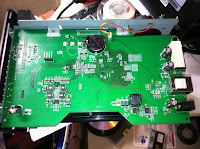The unit I received is the 2TB version, meaning that it had a pair of 1TB, 5900 RPM SATA-2 disks (Seagate ST31000520AS, to be exact). You can find reviews of this unit (and its drives) all over the Internet, both singing its praises as well as trashing iomega, EMC and anyone considered foolish enough to entrust data to the device.
In a nutshell, the unit is a


It takes advantage of LVM for its flexibility in storage management and data protection. The Linux heritage also gives it a long list of integrated, optional features that make it very interesting to someone that otherwise has no fileserver at home, but unless you're ready to get your hands dirty, it isn't expandable as an application platform. The device exposes its functionality through a very user-friendly web interface, and has four front-panel lights to communicate system status to the user/operator.
Personally, I thought it might be a clever way to store disk images in a shared, network-accessible location without using expensive SAN storage. We currently do it all the time on a regular workstation with a gigantic drive, and I thought this would give us a smaller footprint than a full-size PC. Further, I thought the ~1TB usable storage could be augmented with a Drobo connected via USB as add-on capacity without increasing the physical footprint.
This use case more-or-less failed miserably. Although I knew a mirrored-pair of SATA drives wouldn't have much throughput, I didn't "do the math" ahead of time to see just how bad it would be to save an image. My test platform was pretty basic: I attached a 320GB SATA disk to a USB adapter and began writing the image to a CIFS share. The image was larger than usual because it was a disk I wanted to archive after being in production, not a template image for other production disks.
I gave up on the image when it was 1h into it and was going to take another (estimated) 7h.
Truth is, I didn't expect much out of it given that it's basically a single, slow SATA disk: in mirrored mode, you might get some improvement in reads, but your writes will be penalized a little for the mirror set to stay in sync. The fact that I didn't pay for the thing made the discovery pretty painless.
The second part of the plan was also thwarted: the first-gen Drobo that I plugged into the unit wouldn't show up as attached storage. The Drobo works fine on my Windows 7 desktop, and other types of USB storage worked fine on the ix2. Nope, these two guys just aren't compatible.
So now I'm playing: I picked up a pair of 2TB, 7200RPM SATA-3 drives on sale (Hitachi H3D20006472S), and have proven to myself that it's possible to a) upgrade to faster disk and b) expand the capacity on the ix2. There's no secret to getting a faster disk installed: replace the two disks one-at-a-time (with a disk of same-or-larger capacity) and let the Linux mdadm subsystem resynchronize the data from the remaining disk. Increasing the capacity is a bit more technical, requiring console access (for non-destructive resize); I've not tried it, but it may be possible to resize using a factory reset, but I didn't try it myself. I do know, however, that SSH access and basic understanding of LVM makes storage modification a cakewalk. I've even contemplated resizing the user storage volume down to a bare-minimum in order to replace the disks with SSDs. The capacity is miniscule compared to spinning-disk, but the experiment to see how fast it could be is kind of compelling...
At any rate: I'm in the process of building a table of performance data from iometer, and I'm including not just the stock drives, but the upgraded pair, my 1st-gen Drobo and my Drobo Pro. I'm also going to include the results from a pair of 128GB Kingston SSDs in a stripe set (RAID 0) from my desktop machine as a "best-case scenario" for comparison.
And finally, one might think that my experience with the ix2 would have soured me on the whole line of products. It hasn't. I also have a 4TB (raw) ix4-200d that I picked up for cheap on eBay which I've proven to myself makes a stellar backup target for VMware environments using NFS. I will add the performance metrics from that unit to my results, as well as the results I get when I finish upgrading its disks from 4x1TB 5900RPM units to 4x2TB 7200RPM units. I am predicting that I will be much happier with the performance of the upgraded ix4 than the performance I'm currently getting out of the Drobo Pro.
Stay tuned!


is 1GHz
ReplyDeleteThe post has been corrected; although the chip self-identifies in Linux as an "ARM926EJ-S rev 1", it's really a Marvell Kirkwood. ARM documentation does not apply.
ReplyDeleteGreat posts, I want to upgrade my ix2 to 2 x 3TB. Is the ix2 limted in anyway as far as drive type and drive capacity is concerned? Do I need to upgrade to cloud edition first? I was thinking of getting a couple of WD30EURS from newegg. What do you think?
ReplyDelete@Anonymous: I don't have any personal experience with 3TB drives (at all), so I can't make any sort of hard/fast recommendation. Because the devices seem to support 2TB drives with the 4K block-size, I'd have a high level of confidence that they could support the 3TB drives. Just make sure you get the low-power "green" drives so you don't have a lot of heat build-up in the case.
ReplyDeleteI have an ix2-200 running 2x4TB drives - HGST Deskstar NAS (HDN724040ALE640)
ReplyDelete